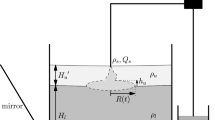Abstract
This study investigates the baroclinic instability of a two-layer rotating fluid system. The instability is generated by releasing a cylinder of buoyant fluid at the surface of ambient fluid. The buoyant fluid is dyed so that its depth may be determined from its optical thickness. The system first adjusts until the horizontal density gradient is balanced by a flow along the front, and the adjusted state is then unstable to azimuthal waves. Contours of constant upper layer depth are examined, and the perturbation at each azimuthal wavenumber is determined. The initial wavenumber is well modelled by simple quasi-geostrophic theory. There is a clear high wavenumber cutoff, and a transfer of energy to larger scales with time.
Similar content being viewed by others
References
Gill, A.E., Green, J.S.A. and Simmons, A.J., Energy partition in the large-scale ocean circulation and the production of mid-ocean eddies.Deep-Sea Res. 21 (1974) 499–528.
Barnett, S.J., A vertical buoyant jet with high momentum in a long ventilated tunnel.J. Fluid Mech. 252 (1993) 279–300.
Dalziel, S.B., Decay of rotating turbulence: Some particle tracking experiments.Appl. Scientific Res. 49 (1992) 217–244.
Dalziel. S.B., Rayleigh-Taylor instability: Experiments with image analysis.Dyn. Atmos. Oceans 20 (1993) 127–153.
Saunders, P.M., The instability of a baroclinic vortex.J. Phys. Oceanogr. 3 (1973) 61–65.
Griffiths, R.W. and Linden, P.F., The stability of vortices in a rotating stratified fluid.J. Fluid Mech. 105 (1981) 283–316.
Phillips, N.A., Energy transformations and meridional circulations associated with simple baroclinic waves in a two-level, quasi-geostrophic model.Tellus 6 (1954) 273–286.
Hart, J.E., An experimental study of nonlinear baroclinic instability and mode selection in a large basin.Dyn. Atmos. Oceans 4 (1980) 115–135.
Hart, J.E., Wavenumber selection in nonlinear baroclinic instability.J. Atmos. Sci. 38 (1981) 400–408.
Pedlosky, J., The non-linear dynamics of baroclinic wave ensembles.J. Fluid Mech. 102 (1981) 169–209.
Barnett, S.J., The dynamics of buoyant releases in confined spaces. PhD Thesis, DAMTP, Cambridge University (1991).
Holford, J.M., The evolution of a front. PhD Thesis, DAMTP, Cambridge University (1994).
Griffiths, R.W. and Linden, P.F., Laboratory experiments on fronts. Part I: Density-driven boundary currents.Geophys. Astrophys. Fluid Dyn. 19 (1982) 159–187.
Author information
Authors and Affiliations
Rights and permissions
About this article
Cite this article
Holford, J.M., Dalziel, S.B. Measurements of layer depth during baroclinic instability in a two-layer flow. Appl. Sci. Res. 56, 191–207 (1996). https://doi.org/10.1007/BF02249381
Received:
Revised:
Issue Date:
DOI: https://doi.org/10.1007/BF02249381




